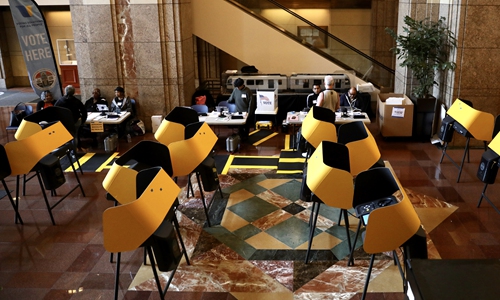HOME >> WORLD
Massive changes to California voting spark fears of Iowa-style primary chaos
Source:Reuters Published: 2020/2/27 19:03:41

Voting centers began to open on February 22, in Los Angeles County, California, 11 days ahead of the primary election. For the first time, LA County voters have started using a modern touch-pad ballot marking device to make their selections. However, the early voting set off to a slow start the first day when the voting locations opened to voters. Photo: Yu Yan
As he looks ahead to California's March 3 Democratic primary, Neal Kelley is having sleepless nights.
Kelley is the elections chief for Orange County, part of a wave of California counties rolling out sweeping new balloting procedures affecting millions of voters in the nation's most populous state.
He has good reason to be worried.
Memories of the chaos that plagued Iowa's first-in-the-nation caucuses on February 3 have election officials nationwide looking to avoid similar embarrassment. Iowa's results were delayed for days, in part because of the failure of an unproven vote-counting app.
Some mammoth California counties are unveiling their own new voting technology. They're also eliminating thousands of polling places in the hopes that voters will make use of expanded mail-in balloting or take advantage of extended early in-person voting.
The stakes are high. With 415 delegates up for grabs - the largest haul in the country, accounting for more than 20 percent of the 1,991 delegates a candidate must win to secure the Democratic nomination on the first ballot - California will have considerable influence in choosing the eventual nominee. Its early primary this year will give the Golden State even more sway. Four years ago, its primary was held in June.
That also means a California-sized screw-up would dwarf the dysfunction in Iowa.
"I'm not going to sit here and say nothing can go wrong," Kelley said. "It's a transition to a whole new system of voting. I am getting very little sleep."
California's shift stems in part from a 2016 state law known as the Voter's Choice Act aimed at making voting easier and more flexible for the state's 20.5 million registered voters. California's 58 counties can choose whether to participate. Five did so in the 2018 election cycle. Another 10 are making the leap this year. Combined, they account for half of California's electorate.
Los Angeles County - the state's largest county with 5.4 million registered voters - has embarked on a parallel modernization program of its own. Part of its effort includes new voting machines, which are already drawing scrutiny.
The city of Beverly Hills in January filed a lawsuit demanding changes to the new touch-screen system, which displays just four candidates at a time. To see additional candidates voters must navigate a "confusing series of steps" that raises the risk they won't see all the available choices, the lawsuit alleges. For example, California's Democratic primary ballot lists 20 presidential candidates, only eight of whom are still in the race.
A ruling is not expected before the March 3 primary, according to Beverly Hills City Attorney Laurence Wiener.
Mike Sanchez, a spokesman for the Los Angeles County Registrar-Recorder/County Clerk, the office in charge of elections, declined to discuss the lawsuit. He said the agency held a mock election in September to test the new equipment and made improvements based on user feedback, including upgrades to the buttons that help voters navigate the candidate lists.
Orange County, too, is introducing new digital voting machines, albeit by a different manufacturer. Kelley, the county's registrar of voters, said there are large prompts at the bottom of each screen as well as "ultra-clear" orange scroll buttons to ensure voters can see all the candidates.
The new electronic voting machines in Los Angeles and Orange counties do not themselves count ballots.
After voters key in their choices, the machines print out paper ballots showing their selections. Once satisfied, voters place their completed ballots into drop boxes in the machines.
The ballots are later collected by election workers and taken to a secure location where they are counted via a central tally system. Voters are not required to use the machines; they can fill out paper ballots by hand if they prefer.
Posted in: MORE NEWS